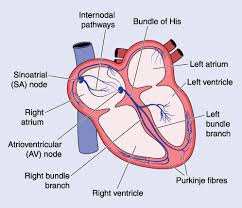 Atrioventricular (AV) ablation is a medical procedure used to treat certain types of arrhythmias, particularly when other treatments have failed or are not tolerated by the patient.
Atrioventricular (AV) ablation is a medical procedure used to treat certain types of arrhythmias, particularly when other treatments have failed or are not tolerated by the patient.
It is primarily used for patients with atrial fibrillation (AF) or atrial flutter that causes a rapid and irregular ventricular response.
The procedure involves using radiofrequency energy or cryotherapy to destroy/ablate the AV node or His bundle, which are parts of the heart’s electrical conduction system.
By ablating the AV node, the procedure blocks the transmission of abnormal electrical signals from the atria to the ventricles preventing rapid and irregular ventricular rates.
Since the AV node is destroyed, patients require a permanent pacemaker implantation to control the heart rate.
The pacemaker therefore ensures a regular, appropriate ventricular rhythm.
AV ablation is typically considered when rate control medications (like beta-blockers or calcium channel blockers are ineffective or cause side effects, or when rhythm control strategies of antiarrhythmic drugs or cardioversion) have failed.
AV ablation can significantly improve symptoms such as palpitations, shortness of breath, fatigue, and dizziness by controlling the ventricular rate.
Risks of AV ablation include: bleeding, infection, damage to blood vessels or heart structures, and risks associated with pacemaker implantation.
7. Post-procedure: Patients may still require anticoagulation if they have AF, as AV ablation does not cure AF itself.
AV ablation is a definitive treatment for rate control in certain arrhythmias but does not eliminate the arrhythmia itself.
It’s generally reserved for patients who have not responded to or cannot tolerate other treatments.
